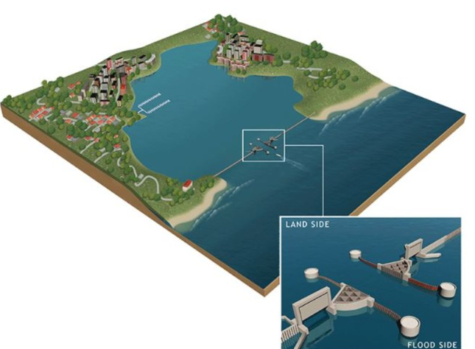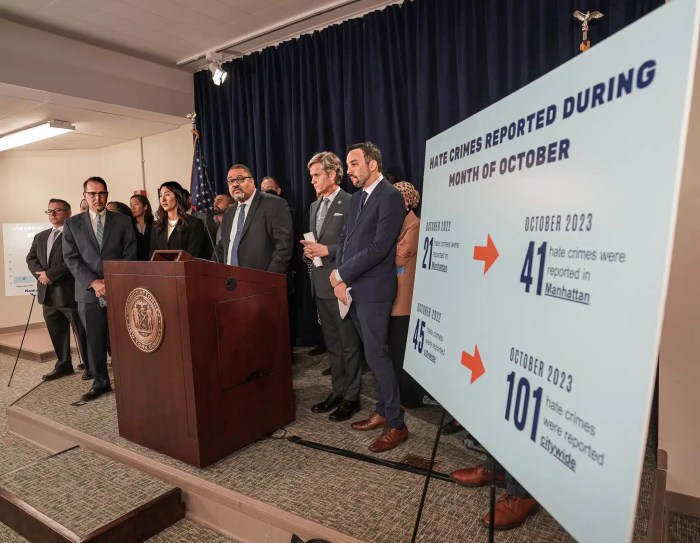
Geoengineering – it’s a word created to describe altering the earth and has mostly been applied to the climate crisis. The Royal Society of Great Britain, the oldest national scientific organization in the world (its roots go back to 1660), defines geoengineering as “the deliberate large-scale intervention in the Earth’s climate system, in order to moderate global warming.”
Geoengineering is being proposed widely these days.
Regarding Fire Island, the U.S. Army Corps of Engineers (USACE) has urged a massive steel and concrete structure that would close the mouth of Fire Island Inlet to prevent hurricane storm surges from inundating Long Island’s south shore.
USACE, further, is considering such structures further west, at Rockaway and Jones inlets.The plan is laid out in a document issued by USACE in 2019, entitled “Nassau County Back Bays Coastal Storm Risk Management Feasibility Study.”
“Conceptually, the simplest approach to reduce flood risk in the back bays would be to prevent storm surge in the Atlantic Ocean from entering the back bays,” the document states. “This can be accomplished with structures at each inlet that can be closed when needed to reduce back bay flooding, but remain open to tidal exchange in non-storm conditions.”
“Such structures,” it goes on, “are referred to as ‘storm surge barriers,’ and examples of this type of structure exist at a number of locations around the world, including several in the U.S. Although storm surge barriers can be effective in reducing back bay flooding during more intense, less frequent coastal storm events, it is necessary that storm surge barriers remain open most of the time in the interests of navigation and back bay environmental and water quality. Consequently, storm surge barriers cannot be operated in a manner that significantly reduces impacts from more frequent but less intense storm events…”
Also, USACE has proposed a six-mile long barrier between New Jersey and Breezy Point in Queens, with swinging steel gates to protect Manhattan from a hurricane surge.
But in February of 2020, the Trump administration “unexpectedly halted” that $119 billion plan – yes $119 billion – calling it “foolish,” according to The New York Times.
A City Hall spokesperson termed the cancellation “unacceptable” and “dangerous,” calling on the federal government to “reverse course immediately.” The article continued by stating that “it is highly unusual for a [USACE] project to lose funding after more than three years of work at a cost of several million dollars.
”Will the Biden administration reactivate the scheme?In Europe, there’s the Venice geoengineering project.
In and near Venice, because of the climate crisis, waters have risen higher and higher. So in 1966, engineers began to “draw up plans to build a barrier at sea to defend one of the world’s most picturesque yet fragile cities from the constant threat of high tides,” Reuters has noted. “But the project, known as Mose (for Moses and the parting of the Red Sea), has been plagued by the sort of problems that have come to characterize many Italian construction programs – corruption, cost overruns and prolonged delay.” There was a threefold increase in cost to $6.1 billion.
“Floodgates in Venice Work in First Major Test,” was The New York Times headline on Oct. 3, 2020. The Mose undertaking involves 78 steel barriers at three inlets. They had just been raised in the face of a particularly menacing tide. “Everything dry here,” tweeted Luigi Brugnaro, mayor of Venice.But the Mose project remains contested.
The article further mentions: “Christiano Gasparetto, an architect and former provincial official who has long opposed the project” said, “With climate change, there’s a chance that the floodgates could be employed 150-180 days a year, becoming an almost fixed barrier and severing the [Venice] lagoon’s relations to the sea. If the lagoon is cut off from the sea for long periods, it dies, because the natural exchange of water stops, and all of its organic life risks decaying.”
Recently, the PBS “Nova” series devoted an hour to such ambitious geoengineering concepts in a program, titled “Can We Cool The Planet?” Is a focus on trying to deal with the effects of global warming overshadowing getting at its cause?
The climate crisis is largely caused by the burning of fossil fuels – oil, gas and coal – all which contribute to the release of carbon dioxide that leads to a heat-up of the planet. It’s causing glaciers to melt and seas to rise. This has resulted in unusually powerful hurricanes, and in high numbers.
Indeed, 2020 saw a record number of hurricanes with the World Meteorological Organization needing to reach deep into the Greek alphabet to name storms after its list of English names had been used up.
The warming of seas has increased the heat in them on which hurricanes feed. The climate crisis also is seen as being behind the massive wildfires of this year. It has thrown nature out of whack world-wide.A full transition to energy sources led by solar and wind, which do not produce greenhouse gasses, is required to challenge global warming – and the technology is already here today to accomplish that.Fire Island, Long Island, and New York City, with their miles upon miles of shoreline, are especially vulnerable to the climate crisis and rising waters.
There are the calls for the “relocation” of structures in the most exposed, most vulnerable areas – Fire Island has already begun witnessing all that is lost in such drastic decision making in recent years. However we should also be a leader in challenging the cause, and to be in the forefront of a transition from burning fossil fuels in cars and trucks and in the generation of electricity.
Some geoengineering schemes may work, at a massive cost, others may not. But the cause of the climate crisis must be fully tackled. Otherwise, waters will continue to rise and other effects persist and worsen, and the Earth will move past a point of no return. Challenging the cause of global warming without delay is an existential necessity.































